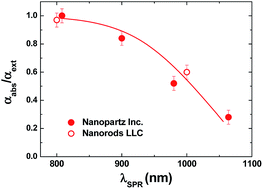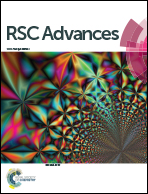Gold nanorods for optimized photothermal therapy: the influence of irradiating in the first and second biological windows†
Abstract
The light-to-heat conversion efficiency of gold nanorods (GNRs) with surface plasmon resonances in the first (700–950 nm) and second (1000–1350 nm) biological windows has been studied by Quantum Dot based Fluorescence Nanothermometry. It has been found that red-shifting the GNR longitudinal surface plasmon resonance wavelength (λSPR) from the first to the second biological window is accompanied by a remarkable (close to 40%) reduction in their heating efficiency. Based on numerical simulations, we have concluded that this lower heating efficiency is caused by a reduction in the absorption efficiency (ratio between absorption and extinction cross sections). Thermal stability and ex vivo experiments have corroborated that GNRs with λSPR at around 800 nm seem to be especially suitable for efficient photothermal therapies with minimum collateral effects.


 Please wait while we load your content...
Please wait while we load your content...